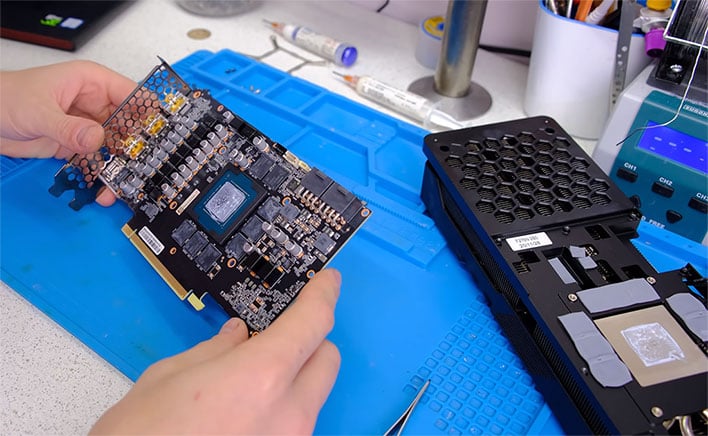Watch This Gutsy GeForce RTX 3070 DIY Memory Upgrade To 16GB

When it comes to cutting edge PC hardware, modding is not always for the faint of heart. Or in the case of NVIDIA's GeForce RTX 3070 series, all of which sell for a mint by marketplace sellers, modding is not for the faint of wallet or purse. Nevertheless, the scarcity of GPUs and jacked up pricing did not stop a Russian modder from carefully peeling off the memory chips on a GeForce RTX 3070 and replacing them with more capacious ones.
As we discovered in our GeForce RTX 3070 review, the $499 (MSRP) graphics card is a stout part for gaming, trading blows with last generations GeForce RTX 2080 Ti. That's a win, considering the 3070 is supposed to start at $499 (MSRP), with custom models sporting fancy cooling solutions and factory overclocks commanding a bit more.
The reality is, all of the latest GPUs command a big premium right now, because there is a shortage. Looking at eBay's completed auctions, we see many GeForce RTX 3070 cards have sold for north of a grand (there's no telling how many of those are fake, to spoil the fun for scalpers). So yeah, tearing off the memory chips, not matter how careful, carries added financial risk right now.
Modder "VIK-on" did it anyway, just as he had done on a GeForce RTX 2070 last year. Like last time, his goal was to double the memory from 8GB to 16GB. How did it go? Surprising well, actually, with a few hiccups along the way.
For his experiment, VIK-on used a Palit GeForce RTX 3070 GamingPro model, which is one of a half dozen 3070 cards the company offers (others include the GamingPro OC, JetStream, JetStream OC, GameRock, and GameRock OC).
After carefully removing the warranty sticker, he opened up the card and proceeded to heat up the eight Samsung 1GB GDDR6 memory chips, lifting each one off with tweezers. He then replaced them with 2GB GDDR6 modules, also made by Samsung.
This is where things get tricky (or trickier). Ideally, VIK-on would be able to mod the BIOS to support the new memory arrangement. However, NVIDIA does not make this easy—according to VIK-on, you can't just go in with a HEX editor and change the BIOS, and even NVIDIA's add-in board (AIB) partners can't make changes without the company getting involved.
An end-around is needed for the card to recognize and support 16GB of memory. This involves strap settings. When set to 00000 bits, the card is configured for 1GB Samsung chips. After some trial and error, VIK-on discovered that 00110 supports 2GB modules, and he was off and running. Well, sort of.
While the card was correctly identified as having 16GB of memory, it was not stable. As suggested by one of his fans, he loaded up EVGA's Precision utility and locked the card's frequency, which solved the black screen crashes he was getting. The result was a stable card that did perform a little bit better in 3DMark Time Spy and Unigine Superposition 8K.
The nominal gain is not really worth the risk, so this is one of those 'Don't try this at home' affairs. However, it's certainly need, and deserving of a hat tip.

